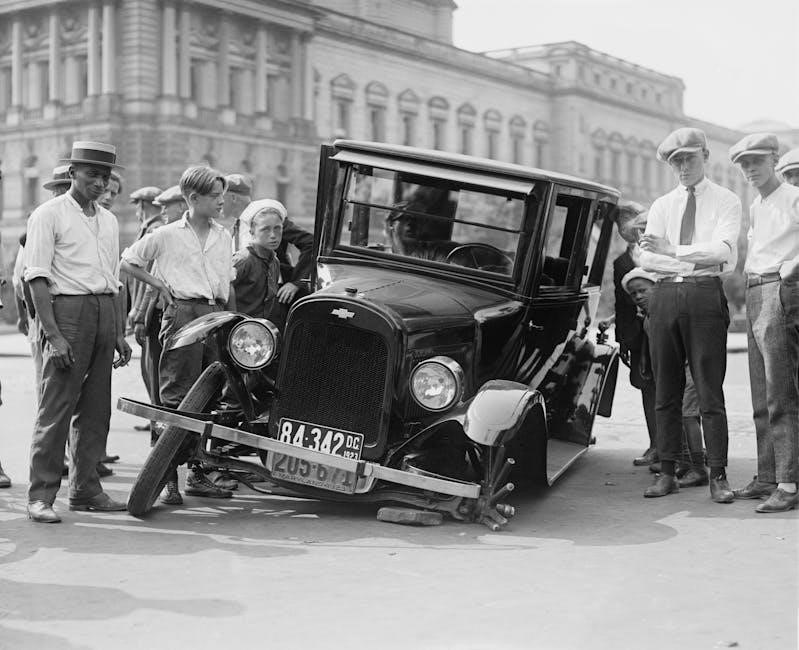The Chevy Malibu manual is a comprehensive guide designed to help owners understand and maintain their vehicle effectively. It covers essential features, safety tips, and maintenance schedules, ensuring optimal performance and longevity of the car.

1.1 Importance of the Owner’s Manual
The owner’s manual is a vital resource for Chevrolet Malibu drivers, providing essential information to ensure safe and optimal vehicle operation. It contains detailed instructions for understanding features, troubleshooting issues, and maintaining the car’s performance. By referencing the manual, owners can identify potential hazards, understand warning symbols, and follow recommended maintenance schedules to prolong the vehicle’s lifespan.
The manual also serves as a quick reference guide, helping drivers navigate through complex systems and technologies integrated into the Malibu. Its alphabetical index allows users to locate specific topics efficiently, making it an indispensable tool for both new and experienced owners. Regularly consulting the manual ensures drivers are well-informed about their vehicle’s capabilities and limitations, enhancing overall driving safety and satisfaction.
1.2 Brief Overview of the Chevy Malibu
The Chevrolet Malibu is a mid-size sedan known for its blend of style, comfort, and advanced technology. It features a sleek design, both inside and out, with a focus on driver convenience and passenger comfort. The Malibu is equipped with modern infotainment systems, intuitive controls, and a range of safety features. Its fuel-efficient engine options provide a balance between performance and economy, making it a practical choice for daily driving. Available in various trim levels, the Malibu caters to different preferences, offering customization options for interior and exterior aesthetics. Whether for commuting or long trips, the Malibu is designed to deliver a smooth and enjoyable driving experience. Its versatility and reliability have made it a popular choice among car enthusiasts.

How to Download the Chevy Malibu Manual
Visit Chevrolet’s official website, select your Malibu model year, and download the PDF manual. Ensure compatibility with your vehicle’s specific year and configuration for accuracy.
2.1 Steps to Find and Download the Manual
To find and download the Chevy Malibu manual, start by visiting Chevrolet’s official website or a trusted third-party manual database. Navigate to the “Support” or “Owners” section. Select your Malibu model year from the dropdown menu. Choose the appropriate manual type, such as the owner’s manual or service manual. Click the download link to access the PDF file. Ensure your device has enough storage space. Once downloaded, open the manual using a PDF viewer. Verify the manual matches your vehicle’s make, model, and year for accuracy. For older models, manuals may be available through authorized dealerships or online forums. Always use a secure connection to avoid downloading unauthorized or malicious files.
2.2 Availability of Manuals for Different Years
Chevy Malibu manuals are available for various model years, ensuring compatibility with your specific vehicle. Manuals for recent models, such as 2023 and earlier, can be easily accessed online through Chevrolet’s official website or authorized dealerships. For older models, dating back to the 1990s, manuals may still be available in digital or physical formats. Third-party websites and forums also host a wide range of Chevy Malibu manuals, catering to different years and trim levels. Some websites offer free downloads, while others may require registration or a small fee. Ensure the manual matches your vehicle’s exact year and configuration for accurate information. Manuals for discontinued or limited-edition models may be less common but are often archived by enthusiasts or specialty automotive communities.
2.3 Free Resources for Downloading the Manual
Several free resources are available for downloading the Chevy Malibu manual. The official Chevrolet website offers free access to owner’s manuals for various model years, ensuring authenticity and reliability. Additionally, third-party websites like ManualsLib and ManualsOnline provide free downloads for Chevy Malibu manuals. These platforms host a wide range of manuals, making it easy to find the one that matches your vehicle. Some forums and automotive communities also share free PDF versions of the manual, uploaded by users. Always verify the source to ensure the manual is accurate and complete. Downloading from trusted websites is crucial to avoid malware or incorrect information. These free resources make it convenient for owners to access their Chevy Malibu manual without any cost.

Key Features of the Chevy Malibu
The Chevy Malibu offers a sleek exterior design, a spacious interior, and advanced technology features like an intuitive infotainment system. It also boasts impressive safety features and efficient engine options, ensuring a smooth and safe driving experience.
3.1 Overview of the Vehicle’s Design and Technology
The Chevy Malibu combines a sleek, aerodynamic exterior with a refined interior, offering a modern driving experience. Its design features a sloped roofline, chrome accents, and LED lighting, creating a sophisticated look. Inside, the cabin is equipped with premium materials, ambient lighting, and a dual-cockpit design for enhanced comfort and functionality. The Malibu also incorporates advanced technology, including an intuitive infotainment system with a touchscreen display, Chevrolet Infotainment 3 Plus, and compatibility with Apple CarPlay and Android Auto. Additional features include USB ports, wireless charging, and innovative driver-centric technologies like the Driver Information Center. These elements ensure a seamless blend of style, comfort, and cutting-edge innovation.
3.2 Safety Features and Driver Assistance Systems
The Chevy Malibu is equipped with a comprehensive suite of safety features and advanced driver assistance systems. It boasts a 5-star overall safety rating and comes standard with a total of six airbags, including front, side, and knee airbags. The Malibu also features Forward Collision Alert, Automatic Emergency Braking, and Adaptive Cruise Control, which help prevent accidents. Lane Keep Assist with Lane Departure Warning ensures the vehicle stays within lane markings, while the Following Distance Indicator promotes safe driving habits. Additionally, the Rear Cross Traffic Alert and Blind Zone Alert systems enhance visibility and awareness. These technologies, part of the Chevrolet Safety Alert Package, work together to provide a safer and more confident driving experience.
3.3 Fuel Efficiency and Performance
The Chevy Malibu delivers exceptional fuel efficiency and balanced performance, making it a practical choice for daily driving. The base model features a 1.5L turbocharged 4-cylinder engine, producing 160 horsepower and 184 lb-ft of torque, while offering an estimated EPA rating of 29 MPG in the city and 36 MPG on the highway. For enhanced power, an optional 2.0L turbocharged engine is available, generating 250 horsepower and 260 lb-ft of torque. Both engines are paired with an 8-speed automatic transmission, ensuring smooth acceleration and responsive handling. The Malibu also features a refined suspension system, providing a comfortable ride while maintaining precise control. With its efficient engine options and agile performance, the Malibu is designed to meet the needs of both commuters and enthusiasts alike.

Maintenance and Servicing Guidelines
Regular maintenance ensures optimal performance, safety, and longevity for your Chevy Malibu. Routine inspections, oil changes, and tire rotations are essential. Follow the recommended schedule in your manual for proper care.
4.1 Recommended Maintenance Schedule
Adhering to the Chevy Malibu’s recommended maintenance schedule ensures optimal performance and longevity. Routine services include oil changes every 5,000 to 7,500 miles, depending on driving conditions. Tire rotations should occur every 7,500 miles to maintain even tread wear. Brake pads and rotors should be inspected every 12,500 miles, while spark plugs are typically replaced at 100,000 miles. The air filter should be checked every 15,000 miles and replaced as needed. Belt replacements, such as the serpentine belt, are recommended at 50,000 to 105,000 miles. Regular inspections of fluids, hoses, and battery health are also crucial. Always consult your owner’s manual for specific intervals tailored to your model year and driving habits to prevent potential issues and keep your Malibu running smoothly.
4.2 Oil Change and Fluid Check Instructions
Changing the oil in your Chevy Malibu is essential for maintaining engine health. Start by gathering materials: oil filter wrench, new oil filter, motor oil (the recommended type is specified in your manual), drain pan, and gloves. Locate the oil drain plug underneath the car and use the wrench to loosen it. Allow the old oil to drain completely before replacing the plug. Next, remove the old oil filter and install a new one. Refill the engine with the recommended amount and type of oil. After completing the oil change, check other fluids: coolant, brake fluid, transmission fluid, windshield washer fluid, and power steering fluid. Ensure all levels are within the recommended range and top them off if necessary. Always refer to your manual for specific guidelines and safety precautions to avoid overfilling or using incorrect fluids. Regular fluid checks help prevent damage and ensure optimal vehicle performance.
4.3 Tire Rotation and Pressure Guidelines
Proper tire maintenance is crucial for safety, efficiency, and longevity. Rotate tires every 5,000 to 8,000 miles to ensure even tread wear and improved handling. Use the pattern recommended in your Chevy Malibu manual, typically rearward cross or forward cross, depending on your vehicle’s specifications. Check tire pressure monthly and before long trips, using the pressure specified in your manual or on the tire information label on the driver’s doorjamb. Avoid under-inflation, as it can reduce fuel efficiency and increase wear. Inspect the spare tire regularly and ensure it is inflated to the recommended pressure. Proper tire care enhances safety, improves fuel economy, and extends the life of your tires. Always refer to your manual for specific guidelines tailored to your Malibu model and driving conditions.

Troubleshooting Common Issues
Identify symptoms, refer to diagnostic sections, and perform corrective actions. Check warning lights, instrument cluster messages, and consult the manual for solutions to common mechanical or electrical faults.
5.1 Identifying Warning Lights and Their Meanings
The Chevy Malibu manual provides detailed explanations of dashboard warning lights. These lights indicate issues such as low oil pressure, battery problems, or ABS malfunctions. Red lights often signal critical issues, while yellow or orange lights may indicate less urgent concerns. Common symbols include the check engine light, tire pressure monitor, and seatbelt reminders. Understanding these symbols is essential for addressing problems promptly. Refer to the manual’s diagram section for visual identification and meanings. If a light illuminates, consult the corresponding page for troubleshooting steps or recommended actions. Always address illuminated warnings to prevent potential damage or safety risks. Regularly reviewing this section helps drivers stay informed and proactive about their vehicle’s condition.
5.2 Solving Common Problems with the Malibu
The Chevy Malibu manual outlines solutions for common issues, such as the check engine light, infotainment glitches, or start/stop technology malfunctions. For the check engine light, the manual recommends checking the gas cap, scanning for codes, and addressing issues like loose connections or faulty sensors. If the infotainment system freezes, restarting the vehicle or updating the software often resolves the problem. For issues with the start/stop feature, ensure the battery is fully charged and consult the manual for recalibration steps. Addressing these problems promptly ensures optimal performance and prevents further complications. Always refer to the troubleshooting section for detailed guidance tailored to your specific concern.
5.3 Resetting the Oil Change Indicator
To reset the oil change indicator on your Chevy Malibu, start by turning the ignition to the “ON” position without starting the engine. Locate the trip button on the instrument cluster and press it until the “OIL LIFE” display appears. Once visible, press and hold the trip button for approximately 5-10 seconds until the oil life percentage resets to 100%. If the above method doesn’t work, try pressing the gas pedal fully while holding the trip button. Ensure the process is done correctly to maintain accurate maintenance tracking. If issues persist, consult a dealership or mechanic for assistance. Resetting the indicator ensures your vehicle’s maintenance schedule remains up-to-date and prevents unnecessary reminders.

Safety Precautions and Warnings
Always follow safety guidelines in the Chevy Malibu manual to ensure safe operation. Wear seat belts, check airbag status, and understand warning lights. Properly secure children and follow all precautions to avoid accidents and ensure safe driving.
6.1 Understanding Safety Symbols in the Manual
The Chevy Malibu manual uses specific safety symbols to alert drivers to potential hazards. These symbols are standardized to ensure clarity and quick recognition. Common symbols include warnings for airbags, seat belts, and engine temperatures. Each symbol is accompanied by a brief description or diagram to explain its meaning. Understanding these symbols is crucial for safe vehicle operation and maintenance; Always refer to the manual’s legend or glossary section for detailed explanations of each symbol. Familiarizing yourself with these icons can help prevent accidents and ensure compliance with safety guidelines. Regularly reviewing the manual’s safety section will enhance your ability to interpret and respond to these critical indicators effectively.

6.2 Proper Use of Seat Belts and Airbags
Seat belts and airbags are critical safety features in the Chevy Malibu. Always wear your seat belt securely, ensuring the lap belt is snug across your hips and the shoulder belt rests across your chest, avoiding any twisting. Airbags are designed to deploy in conjunction with seat belts to reduce injury risk. Never modify or disable airbags, as this can compromise safety. Properly position children in approved car seats, and ensure all passengers are buckled up. Avoid sitting too close to the steering wheel or dashboard, as airbags need space to deploy safely. Ignoring these guidelines can reduce the effectiveness of safety systems and increase the risk of harm. Always follow the manual’s instructions for optimal protection.
6.3 Child Safety and Car Seat Installation
Ensuring child safety in the Chevy Malibu involves proper car seat installation and adherence to guidelines. Always use a federally approved car seat suitable for your child’s age, weight, and height. The Malibu’s rear seats are ideal for installing car seats, as they provide better protection. Use the LATCH (Lower Anchors and Tethers for Children) system for secure installation, or the vehicle’s seat belt if LATCH is unavailable. Tighten the seat belt or LATCH straps until the car seat is firmly in place; Position the child correctly, with the harness snug and chest clip at armpit level. Avoid loose clothing or items that could interfere with the harness. Refer to the manual for specific installation instructions and weight limits. Always double-check the car seat’s stability before driving.

Technical Specifications of the Chevy Malibu
The Chevy Malibu offers a 1.5L turbo engine and 2.0L turbo option, paired with an 8-speed automatic transmission. It features front-wheel drive, a 112.4-inch wheelbase, and a curb weight of approximately 3,200 pounds. The fuel tank capacity is 13 gallons for the base model, with an estimated EPA rating of up to 32 MPG city and 40 MPG highway. The Malibu’s overall length is 192.1 inches, with a 73-inch width and 57.6-inch height, providing ample space for passengers and cargo. These specs ensure a balanced blend of performance, efficiency, and comfort.
7.1 Engine and Transmission Details
The Chevy Malibu is equipped with a 1.5L turbocharged 4-cylinder engine, producing 160 horsepower and 184 lb-ft of torque. An optional 2.0L turbocharged 4-cylinder engine is also available, delivering 250 horsepower and 260 lb-ft of torque. Both engines are paired with an 8-speed automatic transmission, designed for smooth shifting and optimal performance. The Malibu features front-wheel drive as standard, ensuring consistent traction and control. The transmission includes advanced technologies like Driver Shift Control, allowing manual-like shifting for enhanced driver engagement. These powertrain combinations provide a balance of power, efficiency, and refinement, catering to both daily commuting and spirited driving experiences.
7.2 Dimensions and Weight Specifications
The Chevy Malibu measures approximately 192.1 inches in length, 73.0 inches in width, and 57.6 inches in height, providing a spacious yet manageable footprint. The wheelbase spans about 112.4 inches, contributing to a smooth ride and stable handling. Curb weight ranges from 3,100 to 3,600 pounds, depending on the trim and options. The gross vehicle weight rating (GVWR) is around 4,450 pounds, ensuring ample capacity for passengers and cargo. These dimensions and weight specifications are optimized for a balanced blend of performance, efficiency, and comfort, making the Malibu a versatile choice for various driving needs.
7.3 Fuel Capacity and Mileage Estimates
The Chevy Malibu features a fuel tank capacity of approximately 13 gallons for most models, though hybrid versions may vary slightly. In terms of fuel efficiency, the Malibu offers an EPA-estimated 29 miles per gallon (mpg) in the city, 36 mpg on the highway, and 32 mpg combined for the base model. Higher trims or optional engines may have slightly different ratings. Hybrid models, if available, can achieve even better mileage, often exceeding 40 mpg in combined driving. These estimates make the Malibu a practical choice for commuters and long-distance drivers alike, balancing efficiency with performance. Actual mileage may vary based on driving habits, road conditions, and maintenance.

Customization and Accessories
The Chevy Malibu offers a range of customization options and accessories to enhance functionality and style, including interior upgrades, tech add-ons, and performance-enhancing parts for personalization.
8.1 Available Accessories for the Malibu
The Chevy Malibu offers a wide variety of accessories to customize and enhance your driving experience. Interior accessories include premium floor mats, cargo organizers, and stylish seat covers to protect and personalize your vehicle. Exterior accessories range from spoilers and chrome accents to wheel locks, enhancing both aesthetics and functionality. Tech and infotainment upgrades, such as wireless charging pads or premium audio systems, are also available to keep you connected and entertained on the go. Performance accessories, like high-performance air filters or suspension upgrades, can improve your Malibu’s responsiveness and agility. These accessories are designed to seamlessly integrate with your vehicle, ensuring a perfect fit and maintaining its warranty and safety standards.
8.2 Installing Aftermarket Parts Safely
When installing aftermarket parts on your Chevy Malibu, safety should always be your top priority. Start by consulting your owner’s manual to ensure compatibility and avoid voiding your warranty. Always use OEM-certified or high-quality aftermarket components to maintain your vehicle’s performance and safety standards. Disconnect the battery before working on electrical systems to prevent unexpected power surges. Follow proper torque specifications for bolts and fasteners to avoid damage or safety hazards. Use the correct tools for the job to prevent stripping screws or damaging components. After installation, test the part thoroughly, such as starting the engine or taking a short drive, to ensure everything functions correctly. If unsure, consider seeking assistance from a professional mechanic to avoid potential risks.
8.3 Personalizing Your Vehicle’s Interior and Exterior
Personalizing your Chevy Malibu allows you to tailor its appearance and functionality to your preferences. For the interior, consider adding custom seat covers, dash trim kits, or ambient lighting to enhance comfort and style. Upgrade your infotainment system with aftermarket screens or sound systems for a modern feel. On the exterior, decals, alloy wheels, or body kits can give your Malibu a unique look; Always ensure modifications align with the vehicle’s design and safety standards. Consult the manual to avoid voiding your warranty and to ensure compatibility. For complex changes, seek professional assistance to maintain your Malibu’s performance and aesthetic appeal.
Regularly referencing your Chevy Malibu manual ensures optimal performance and safety. Stay informed about updates, follow maintenance schedules, and explore customization options to enhance your driving experience.
9.1 Importance of Regularly Referencing the Manual
Regularly referencing the Chevy Malibu manual is crucial for understanding your vehicle’s operations, maintenance needs, and safety features. It provides detailed guidance on troubleshooting, ensuring proper care, and optimizing performance. By following the manual, you can identify potential issues early, avoid costly repairs, and maintain your car’s longevity. Additionally, it helps you understand safety protocols, such as airbag systems and seat belt usage, ensuring a secure driving environment. The manual also offers insights into fuel efficiency, driver assistance technologies, and customizations, helping you make informed decisions. Staying informed about updates and recalls through the manual further enhances your ownership experience. Make it a habit to consult the manual regularly for a safer, more enjoyable, and efficient driving experience.
9.2 Staying Informed About Updates and Recalls
Staying informed about updates and recalls for your Chevy Malibu is essential for ensuring safety, compliance, and optimal performance. Regularly check the manufacturer’s website or official communication channels for software updates, feature enhancements, or safety improvements. Recalls are issued to address potential issues that could affect your vehicle’s reliability or safety. Registering your vehicle with Chevrolet ensures you receive timely notifications about recalls or updates. Additionally, you can use the National Highway Traffic Safety Administration (NHTSA) website to check for recalls using your Vehicle Identification Number (VIN). Proactively addressing updates and recalls helps maintain your vehicle’s condition, prevents potential hazards, and keeps you compliant with regulatory standards. Stay vigilant to ensure your Malibu remains safe and up-to-date.